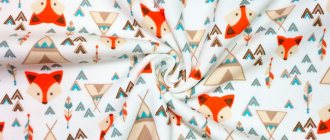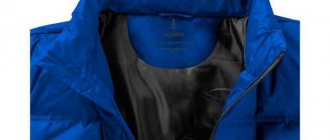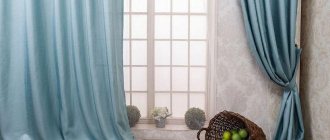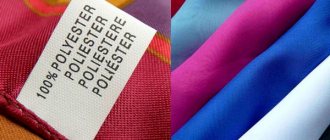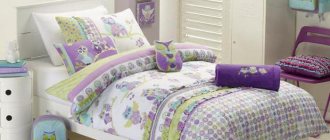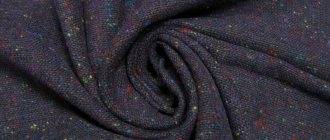What is the difference between acrylic and polyester
These fabrics have slight differences:
- Fiber composition.
- Scope of application.
Fabric making
Acrylic is made from polyacrylonitrile fibers. Thanks to which it is characterized by high strength, light resistance, and heat resistance. They have low thermal conductivity and look like wool. Therefore, first of all, fabric is used as a substitute.
Polyester is made from polyester, which is characterized by low shrinkage, elasticity, and low thermal conductivity. It is called artificial cotton. The material is durable, wear-resistant and does not wrinkle much.
Scope of application
Progress is moving forward. New fabrics are appearing in stores, which contain natural and synthetic fibers. Therefore, it is rare to find 100% acrylic or 100% polyester. Blended fabrics are stronger and more durable. Fabric manufacturers choose these materials.
On a note
To answer the question: which is better, polyester or acrylic, you should be guided by exactly what the fabric is needed for.
Using the table, you will become familiar with the use of polyester and acrylic, their pros and cons, and what fabrics they are mixed with.
| Scope of use | Additional fabric | Characteristics | |
| Polyester | Bed sheets | Cotton | Does not roll down, has increased strength. Dries quickly, does not shrink, does not stretch. Poor air permeability. |
| Lining, upholstery fabric | Cotton, linen, silk | Does not wrinkle, does not absorb moisture and heat. Doesn't stretch. Retains its original condition for a long time. Cleans well. | |
| Insulation materials (isosoft, thinsulate, polyfiber and others) | Made only from polyester | Retains heat well even in severe frosts. Does not change shape after washing. | |
| Women's and thermal underwear | Polyamide | UV resistant and does not change shape when worn. Sticks to the body and does not allow moisture to pass through. | |
| Sportswear, tights, gloves. | Elastane | It stretches well, does not form pills, and does not allow air or moisture to pass through. | |
| Casual wear | Viscose | Does not fade, washes easily, many colors. Things are cozy and pleasant. | |
| Outerwear, umbrellas | Cotton | Resistant to stains and does not allow water to pass through. | |
| Acrylic | Home textiles (plaids, bedspreads) | Cotton | You can make any design, it’s light and doesn’t lose color. Causes static electricity. |
| Stuffed Toys | Cotton | Hypoallergenic, soft, pleasant to the touch. | |
| Knitted products | Wool, cotton | Retains heat, is airtight and pills. | |
| Upholstery of furniture, car seats | 100% acrylic | Wear resistance, resistance to fading and dirt, a large selection of colors, melts. | |
| Curtains | Linen, cotton | Does not fade, durable, drapes well. |
Synthetic fabrics: pros and cons
Synthetic fabrics appeared in the middle of the last century. The first things made from artificial materials were very stylish and fashionable at that time, since they made it possible to use new patterns, dyes, and create inexpensive, but at the same time good-looking clothes. However, over time, it became clear that the new fabrics had very obvious disadvantages. Synthetics do not allow the skin to breathe, may contain harmful impurities, and are contraindicated for allergy sufferers. Cheap, low-quality fabric can easily cause dermatitis even in a person with normal (not problematic) skin. There are also “disadvantages” that manifest themselves when caring for an item: items cannot be ironed at high temperatures, they are easily pulled out, become covered with pellets, and are susceptible to the formation of puffs.
But even completely natural fabrics have disadvantages. This is wrinkleability, a tendency to lose color and shrinkage, and the prickliness of some fabrics. Therefore, in our time, experts usually recommend giving preference to combined fabrics. Ideally, the material should not contain more than 30 percent synthetic additives.
Let's look at artificial materials, clothes made from which can often be seen in clothing stores, and talk about their features.
The composition is the same material from which film and plastic are made, only less dense. Hence the properties of polyester: it is very durable, wear-resistant, holds color well, and does not “shrink” after washing. Polyester looks like fine wool. The material is actively used when sewing casual and sportswear.
What is the difference between natural, artificial and synthetic fabrics?
Many people mistakenly believe that artificial and synthetic fabrics are the same thing. Meanwhile, such matter has different origins and composition. In the first case, we are talking about a material obtained artificially from natural raw materials (proteins, metals, glass, cellulose). In the production of synthetic fibers, compounds are used that were obtained through chemical synthesis and are not found in nature (compounds of carbon, hydrogen, nitrogen).
Acrylic fabric
Natural fabrics are made exclusively from natural raw materials without the use of chemicals. Modern industry has reached such a high level that often artificial and synthetic materials are many times superior to natural ones in terms of performance and aesthetic qualities. Despite this, it is still customary to separate artificial and synthetic fibers from natural fibers when classifying certain products.
Viscose: not natural, but not synthetic either
Viscose is a material artificially produced from natural raw materials - wood cellulose. The advantages of viscose fabric include:
- softness;
- high thermal conductivity;
- drapeability;
- antistatic;
- color fastness;
- ease of coloring;
- hygroscopicity;
- strength;
- hypoallergenic;
- ease;
- breathability.
Viscose
Among the disadvantages of this fabric are:
- high pillability with improper care;
- tendency to shrink;
- vulnerability to mechanical stress when wet;
- low ultraviolet resistance;
- high creasing.
A little about the materials themselves
Features of acrylic:
- It is a synthetic material made from natural gas processing.
- In appearance, acrylic is slightly similar to wool, it is just as soft and flexible, and retains heat quite well.
- The disadvantage of the material is the inability to allow air to pass through.
- After washing, the fabric loses its elasticity.
- After some time, acrylic stretches.
- Acrylic fibers are not resistant to high levels of air humidity.
- The material cannot be washed at temperatures above +400C.
- Acrylic fabric should not be wrung out.
Similarities between acrylic and polyester
Both materials are synthetic, so they have a lot in common.
- They are absolutely safe. People with a tendency to allergies can safely wear them.
- The price is significantly lower than natural ones, which makes it accessible to all buyers.
- Available in a huge range of colors. Do not lose their shades when exposed to ultraviolet radiation.
- Long service life thanks to wear resistance.
- The materials are dense and do not allow air to pass through. The products are hot and stuffy in summer. Keeps warm in winter. When sweating, the fabric will not absorb excess moisture. Sweat stains will not be very noticeable.
- Fabrics dry three times faster than natural analogues.
- Resistant to mold and moths.
- Generate static electricity. The fabric sticks to the body. It is worth using an antistatic agent to avoid the problem.
- They are afraid of high temperatures. The fibers will lose their properties when heated. The item will become unwearable. You can iron some materials containing polyester and acrylic, subject to caution and a number of rules.
If the fabric appears wrinkled, the operating rules have been violated.
- You should wash things at a temperature no higher than 30 degrees.
Clothes washed at temperatures above 30 degrees may develop wrinkles. Irons and steam generators will not correct the situation.
- The use of bleaches and chlorine-containing products when washing is prohibited. They can ruin the fabric. It is better to take the item to the dry cleaner or try washing it in soapy water.
- Items made from these materials should not be twisted or wrung out too much; simply lay them out on a flat surface or hang them on hangers until completely dry. When spinning in a washing machine, use the minimum speed setting.
Proper washing and ironing will preserve items made from these fabrics for many years. Always look at the label for proper care.
From all of the above, we can conclude that there is no huge difference between the materials. They are made from non-natural fibers, but meet the requirements of GOST and customer requests.
In terms of their properties, modern synthetic fabrics are not inferior to, and in some respects even superior to, natural materials. Acrylic and polyester fabrics are considered one of the most popular materials created from polymer raw materials. To understand which of these types is better and warmer, it is necessary to study their general characteristics, including advantages and possible disadvantages.
Acrylic
It is also polyacrylonitrile,
PAN (volumetric)
,
cashmilon, nitron, orlon, dralon, polyacrly, acrylic, acrylique, acrilik...
The structure is similar to wool and is cheap to produce. This is what made acrylic so popular.
pros
- Painted in any colors and shades, does not fade from sunlight
- Lightweight compared to wool
- Resistant to humidity, high temperatures, acids, alkalis
- Doesn't hurt
- Dries quickly
- Relatively cheap
Minuses
- Not hygroscopic
- Frays (acrylic socks are a bad idea)
- It peels and the pellets are difficult to remove (bulk acrylic rolls off to a lesser extent)
- Electrified
Having absorbed only 1.5% of moisture relative to its own weight, acrylic already becomes wet to the touch. For comparison, under normal conditions wool (a good hygroscopic material) contains 15-17% moisture. In conditions of high humidity, the percentage of water can reach 40% without a significant change in consumer qualities. This is precisely why even slightly damp wool warms well.
@nata_navicula #knittingscience
Polyester based coatings
Polyester
- the most economical type of coating, the basis of which is polyester paint and primer with a total thickness of 25 microns. The surface of the polyester coating is glossy, it copes well with negative atmospheric conditions and resists ultraviolet radiation. The disadvantage of this coating option is its low resistance to mechanical loads, so the use of polyester-coated products in a polluted external environment is not recommended. This type of coating is very often used in private construction and roofing work. Today, the color range allows you to choose the most optimal color and shade, and metal with such a coating will last from 10 to 30 years. This is an affordable option for those who value price-quality ratio. The technical characteristics of this coating are regulated and fixed by GOST 52146-2003, as well as for foreign manufacturers JIS G 3312, EN 10169-1-2003, EN10346-2009.
Agneta MP.
This type of coating has a very long service life of 35-40 years, which is ensured by applying paint to the metal on both sides. On the front side of the product the nominal layer is 30 microns, and on the back side it is 25 microns, the zinc layer is 275 g/m2. The coating contains microparticles that promote copper coloring of the coating. The Agneta coating has very good technical characteristics and physical properties.
Resistance to sunlight, fading, and ultraviolet radiation is only part of the advantages of the Agneta coating. The Swedish concern AkzoNobe, which produces coatings for metal tiles and corrugated sheets, provides a 25-year guarantee.
Viking (Viking) MP.
The main difference between the Viking coating and conventional polyester is its matte texture, which performs a number of functions not only in creating an aesthetic appearance, but also protects the roof from ultraviolet radiation, and is also very resistant to mechanical damage. The Viking coating is a new Swedish development, which has a number of differences from the polyester coating. The increased coating thickness of 35 microns is achieved thanks to the special polymer composition F670. Thanks to a minimum gloss content of only 5%, even in clear weather, bright sun rays will not create glare on the roof. The Viking coating, in comparison with conventional polyester, has superior functional qualities and can be used for 15-20 years.
Velur20 (Velour) GL.
One of the many coatings for galvanized steel products is the Velor polymer coating. The basis of this coating is an improved (modified) textured polyester, which provides resistance to reverse impact, a high degree of protection against cracks and scratches. The coating has a thickness of 35 microns. Metal tiles coated with Velur are also not afraid of color loss, fading or other exposure to direct sunlight, since the color saturation is maintained during long-term use. The manufacturer's warranty is 20 years, but in practice this period increases to 20 -35. Bold architectural solutions can be realized thanks to the deep colors and rich colors of the Velur coating.
Polyester and polyester: what is the difference
Hello! Tell me, please, what is the fundamental difference between polyester and polyester? Sofia F.
To answer the question briefly and quickly, we can say that the main difference is in the density of the fibers and, accordingly, directly in the strength of the materials.
For those who are interested in details, we decided to prepare a more detailed answer about what polyester fabric is, what its advantages are, the main varieties and areas of application of each type. Let's start with the basics.
What kind of fabric is polyester and what is it used for?
Using terminology, let's say that polyester is a synthetic fabric that is obtained by melting a special material called polyethylene terephthalate. Simply put, polyester is a durable and skin-friendly synthetic fabric that is used in the production of a number of other fabric products.
Modern manufacturers present 5 types of this material. Each one is made using extrusion, a special fabric processing technology. During the production process, the fibers are pressed through special filters and cooled. The resulting fabric is subjected to heat treatment, then the material is drawn and trimmed.
What is the difference between polyester and polyester
Returning to the main question. One type of polyester is polyester. This is the newest and most advanced modification of polyester fabric. Its distinctive characteristics were:
- increased strength;
- wear resistance;
- high color fastness;
- low elasticity;
- light weight;
- no unpleasant odor;
- ease of care.
Visually and tactilely, polyester resembles wool. It is rarely produced in its pure form. As a rule, a small percentage of elastane, cotton or viscose fibers are added to the material.
What is polyester used for?
Polyester stands out for its wide range of possible applications. It is actively used in the field of tailoring, in particular, tracksuits. In addition, the material is used in the production of carpets and rugs, furniture covers, strollers, and sports equipment.
Other types of polyester fabrics
Continuing the general topic about polyester fabrics. In addition to polyester, polyester has 4 more types of fabrics:
- Polyester silk is a fabric that visually resembles natural silk. However, it costs much less, and its strength and wear resistance are an order of magnitude higher. Used for sewing clothes.
- Acrylic is the softest, but at the same time durable material. It is often used for making posters, banners, and other street products.
- Lavsan is the simplest and most affordable type of polyester. It is well suited for sewing curtains, light tablecloths, and other home textile products.
- Microfiber is a fabric with the finest fibers. It is soft, breathable and absorbs moisture. Due to these qualities, it is often used for sewing sportswear, as well as bed linen, blankets, and towels.
Otherwise, all varieties of polyester have common characteristic advantages:
- strength;
- ease;
- resistance to dirt, pilling, and creasing;
- low degree of combustion;
- moisture resistance;
- ease of care;
- at an affordable price.
As a rule, fibers of other materials are added to polyester fabrics: cotton, linen, viscose, elastane, wool. This solution allows you to increase the wear resistance of the fabrics, increase the degree of breathability, and simplify the maintenance process.
Is it possible to apply sublimation to products made of polyester and other types of polyester?
Any type of polyester fabric belongs to the category of synthetic materials. Accordingly, they are excellent for applying sublimation to fabrics and perfectly convey the clarity and brightness of images.
Having trouble choosing the right type of polyester material? will help you choose the optimal type of fabric for the manufacture of specific products and apply sublimation to the fabric.
| Polyester | Bed sheets | Cotton | Does not roll down, has increased strength. Dries quickly, does not shrink, does not stretch. Poor air permeability. |
| Lining, upholstery fabric | Cotton, linen, silk | Does not wrinkle, does not absorb moisture and heat. Doesn't stretch. Retains its original condition for a long time. Cleans well. | |
| Insulation materials (isosoft, thinsulate, polyfiber and others) | Made only from polyester | Retains heat well even in severe frosts. Does not change shape after washing. | |
| Women's and thermal underwear | Polyamide | UV resistant and does not change shape when worn. Sticks to the body and does not allow moisture to pass through. | |
| Sportswear, tights, gloves. | Elastane | It stretches well, does not form pills, and does not allow air or moisture to pass through. | |
| Casual wear | Viscose | Does not fade, washes easily, many colors. Things are cozy and pleasant. | |
| Outerwear, umbrellas | Cotton | Resistant to stains and does not allow water to pass through. | |
| Acrylic | Home textiles (plaids, bedspreads) | Cotton | You can make any design, it’s light and doesn’t lose color. Causes static electricity. |
| Stuffed Toys | Cotton | Hypoallergenic, soft, pleasant to the touch. | |
| Knitted products | Wool, cotton | Retains heat, is airtight and pills. | |
| Upholstery of furniture, car seats | 100% acrylic | Wear resistance, resistance to fading and dirt, a large selection of colors, melts. | |
| Curtains | Linen, cotton | Does not fade, durable, drapes well. |
Features of polyester fibers:
Polyester fibers are the basis for polyester. This fabric practically does not wrinkle, does not lose the richness of its color palette from exposure to sunlight, is highly durable and wear-resistant, and is not afraid of organic solvents. The disadvantages include the ability to become electrified. In addition, polyester products are difficult to dye, so if you decide to dye a T-shirt or trousers, you will have to look hard for a quality dye. It will be easier to simply change the shade of the material than to repaint it a different color.
However, recently they are trying in every possible way to eliminate the shortcomings of synthetic fabrics. Polyester is the most common material not only in the clothing industry, but also in the furniture industry.
About care
Is polyester washable? And how to wash a polyester coat? Of course you can. Just one of the advantages of such clothes is easy care. You just need to follow some rules:
This material, after heating above forty degrees, secures the acquired shape. Therefore, it should be machine washed in water at a temperature lower than the above, otherwise it will be difficult to get rid of the formed wrinkles. However, now there are things made from this fiber that can be washed in sixty-degree water
Always pay attention to the label before washing; You can simply wash it by hand and in the machine, selecting the manual delicate cycle. A quick wash is possible if the item is not too dirty;
It is better to soften the water with Calgon, which will increase the washing capabilities and allow you to save on MS: for “soft” water, less powder will be required.
Polyester fabrics dry very quickly. You don't even need to squeeze them in the machine: just squeeze them a little by hand and straighten them in the dryer.
Such products do not need ironing. However, if this is still necessary, then you can iron it through a dampened “hebash” fabric at a medium-temperature iron setting.
Polyester
Aka polyester, PE, PES, PL
Polyester is most often found in plush type yarn.
Its properties are ideal for toys
pros
- Durable (it is most often strung with sequins and woven with lurex)
- Relatively resistant to abrasion
- Few wrinkles
- Does not peel
- Depending on the processing, it can look like cotton, wool or silk.
Minuses
- Not hygroscopic
- Electrified
- Destroyed by chlorine and ultraviolet rays
Monolithic polycarbonate
One of the biggest differences between acrylic and polycarbonate is cost. A sheet of monolithic polycarbonate can cost on average 35% more than acrylic glass.
Monolithic polycarbonate UV-resistant, silver, 6 mm, 2050x3050 mm
few
464.00 BYN /sheet
More details
Monolithic polycarbonate UV-resistant milky, 4mm, 2050x3050 mm
few
310.00 BYN /sheet
More details
Monolithic polycarbonate UV-resistant tinted, 3mm, 2050x3050 mm
we will order for you
232.00 BYN /sheet
More details
Monolithic polycarbonate has the following characteristics:
- 250 times more impact resistant than glass and 30 times stronger than acrylic;
- There are bulletproof versions of the material;
- light transmittance 88%;
- resistant to chips and cracks, very high notch impact strength coefficient - more than 30 kg/sq. m (for plexiglass 2.8 30 kg/sq. m);
- thermoplastic with a minimum operating temperature of -100°C;
- low level of flammability;
- high resistance to acids and other chemicals such as gasoline;
- sheets can be drilled without fear of cracking;
- tinted versions of the material.
Now that you've quickly become familiar with the main differences between acrylic and polycarbonate, let's look at why each material has its own distinctive properties and what opportunities it offers. Obviously, the place to start is by looking at the chemical structure and raw materials that make up these polymers.
Types of sheet plexiglass
Depending on the production technology, as well as on the additives that make up the material, various types of acrylic sheets are produced:
- transparent acrylic sheet with a high degree of light transmission, which does not distort the image;
- transparent colored acrylic, having a uniform color throughout the entire plane. Available in a variety of colors and shades;
- sheet plexiglass of varying degrees of transparency, from partially transparent to completely matte white;
- matte colored organic glass with a wide range of shades;
- corrugated sheets of acrylic, one of the sides of which has a three-dimensional texture. May be white, colored, matte or partially transparent;
Acrylic paint advantages and disadvantages
Acrylic paints and varnishes have the following advantages:
- strength, elasticity, transparency;
- good adhesion;
- coatings with varying degrees of gloss, from glossy to matte surfaces;
- durability is many times higher than oil and alkyd paints;
- weather resistance, light fastness, resistance to ultraviolet radiation;
- easy to grind and polish;
- temperature of use -50…+175 °С;
- washable, resistant to mineral and vegetable oils, grease and gasoline;
- high technology, simplicity and ease of application,
- quick drying: 15...30 minutes at high temperature drying, 1...3 hours at room temperature;
- environmentally friendly, odorless;
- fire safety of water-based and water-soluble paints.
Among the disadvantages are:
- insufficient resistance to solvents;
- acrylic paint does not combine well with other types of film formers;
- loss of properties by water-dispersed materials upon freezing;
- relatively high price.
Elastane (lycra)
The material is somewhat similar to rubber, hence its ability to stretch. Elastane is very durable and does not stretch. Items made from 100% elastane are quite rare, unless we are talking about something like superhero costumes or lycra leggings that were in fashion in the 90s. Elastane threads are added to fabric for sewing underwear and any narrow, tight-fitting items.
This material is obtained from natural gas. It is produced in the form of thin or voluminous threads for the manufacture of knitwear and knitted items. All kinds of sweaters, tights, and socks are made from acrylic and with its addition. If you see a rather voluminous but light-weight item in the store, look at how much acrylic it contains.
Nylon is a substitute for natural silk, very light in weight, durable, smooth, and easy to care for. You should not refuse to purchase something made of wool or cashmere if it contains up to 30% nylon - such a thing will only be stronger, but at the same time retain the properties of natural fabric.
Many people unknowingly classify viscose as a synthetic material. In reality, viscose is obtained by processing cellulose, so it has the properties of natural fabrics. Viscose is breathable, pleasant to the touch, and retains heat.
Our dear readers! We spent several days preparing and publishing this material. It only takes a few seconds to share it on Social Networks
Application area
Various wardrobe items are made from acrylic - from underwear to outerwear, hats and scarves; sportswear and home clothes are made from this material. For the production of clothing, it is often not pure acrylic that is used, but its mixture with natural or other synthetic fibers.
Curtains made from it have good strength and wear resistance. They do not lose color even after prolonged exposure to sunlight. Such curtains do not sag and do not heat up. Acrylic is well suited for curtains with fixed folds.
At the moment, acrylic has a wide range of applications. For example, material containing this fiber is used to make carpets, rugs, draperies, seat covers in public transport, and so on.
In general, the word “Acrylic” is used as a general word for the name of polymers based on acrylic acid derivatives, as well as materials made from them. They began to make from acrylic:
- awnings;
- film for greenhouses;
- workwear;
- advertising signs;
- paints, varnishes;
- baths and so on.
Liquid acrylic is widely used in everyday life, construction and industry. This enamel is wear-resistant and is considered absolutely safe for the environment, as it does not have a harmful effect on the environment.
Liquid acrylic is plexiglass, which is made on the basis of acrylic resins and has strength and high performance properties. The material does not wear out, and if scratches occur, they are easily removed. You can find acrylic bathtubs on sale, which have become a worthy replacement for cast iron ones. By the way, acrylic bathtubs are not inferior in strength to cast iron ones and weigh much less.
“I suffer from allergies to many fabrics, but acrylic suited me. This is a good material and quite warm for our climate.”
Tatiana
“I know from myself that acrylic can replace wool if you are allergic to it. It can manifest itself as redness and swelling of the skin.”
Alexandra
“I knitted a sweater from acrylic yarn. It turned out warm and light and the threads were non-prickly. I’m used to the fact that synthetics tend to electrify, but for some reason this material does not electrify. The sweater looks like new after numerous washes. I washed it by hand.”
Marina
Viscose
Many people quite often confuse viscose with silk. Indeed, the goal of manufacturers is to imitate silk fibers in the structure. It is a cellulose fiber that is made by extruding cellulose pulp, which is obtained from wood or cotton.
The process of producing viscose is chemical, but this does not mean at all that you should abandon this material. Wearing viscose clothing is appropriate in the summer, as it creates a pleasant coolness. Unfortunately, the downside is that viscose shrinks when washed at high temperatures and can tear easily. Viscose can be used to make both summer and winter clothes.
